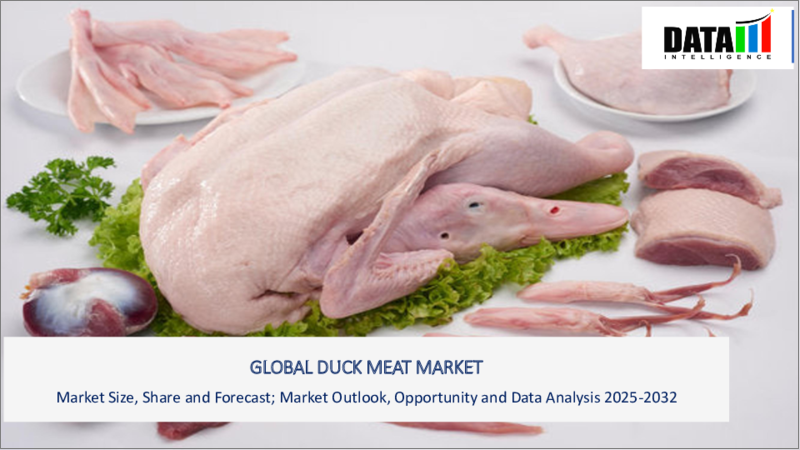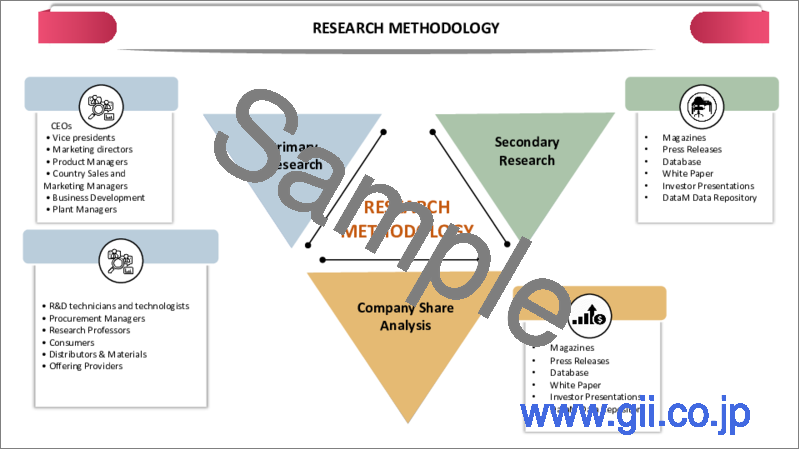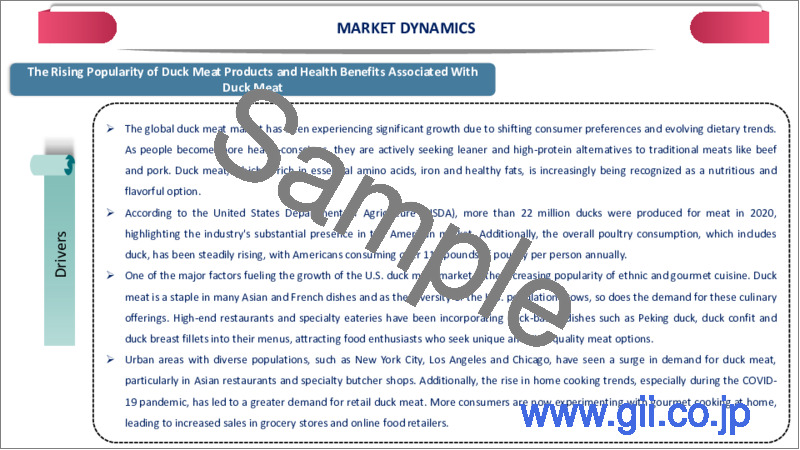|
|
市場調査レポート
商品コード
1304448
鴨肉の世界市場-2023年~2030年Global Duck Meat Market - 2023-2030 |
||||||
カスタマイズ可能
適宜更新あり
|
|||||||
| 鴨肉の世界市場-2023年~2030年 |
|
出版日: 2023年07月07日
発行: DataM Intelligence
ページ情報: 英文 102 Pages
納期: 即日から翌営業日
|
- 全表示
- 概要
- 目次
市場概要
世界の鴨肉市場は2022年に19億米ドルに達し、2023年から2030年の予測期間中にCAGR 2.9%で成長し、2030年には23億米ドルに達すると予測されています。
鴨肉市場におけるひとつのチャンスは、特製およびグルメな鴨製品に対する需要の高まりです。消費者の嗜好や好みが進化するにつれて、ユニークで高品質な食体験への関心が高まっています。このことは、鴨肉市場の生産者やサプライヤーにとって、特製およびグルメな鴨製品を提供することで、この需要に応える好機となります。鴨肉を含む家禽肉にはいくつかの利点があり、世界的に広く消費されています。北京ダック、バリケン、ルーアンダックなど、食肉用に特別に飼育された様々なアヒル品種があり、これらは一般的に食肉用として使用されています。
鴨肉の切り身とは、胸肉、脚、もも、手羽先、枝肉など、精肉工程で分けられるさまざまな部位を指します。鴨製品には、鴨ソーセージ、鴨のコンフィ、鴨胸肉の燻製、鴨の生ハム、鴨のパテなど、鴨肉を使った幅広い食品が含まれます。ドライエイジング、塩漬け、真空調理などの鴨の加工技術は、鴨肉の柔らかさ、風味、ジューシーさを高めるのに役立ち、その結果、消費者に喜ばれる、より高品質な鴨肉製品が生まれます。鴨肉は、さまざまな必須栄養素を含む栄養豊富な食品です。
市場力学
鴨肉製品の人気上昇が市場成長を牽引
鴨肉の味と栄養面での利点に気づく人が増えるにつれ、鴨肉製品の需要が増加する可能性があります。生産者は需要を満たすために生産量を増やす必要があるため、これが鴨肉市場の成長を促進する可能性があります。鴨肉製品の人気上昇に伴い、生産者にとっては製品ラインナップを多様化する機会が生まれる可能性があります。これには、新しい鴨肉製品の開発や、鴨肉ソーセージや鴨肉ハンバーガーなどの付加価値製品の開発が含まれます。
主要プレーヤーによる製品発売の増加は、予測期間中の市場成長を後押しします。例えば、2021年11月07日、鴨肉生産会社であるMaple Leaf Farmsは、鴨のBratwurstとスモークソーセージを市場に投入しました。伝統的な食感と風味を持ち、カロリーと脂肪が少ないです。
鴨肉がもたらす健康効果
鴨肉はビタミンE、ナイアシン、セレンなど様々な栄養素の優れた供給源です。鴨肉1人前で、1日の推奨摂取量の20%以上を摂取できます。鴨肉は必須栄養素の宝庫です。筋肉の成長と修復に不可欠な良質のタンパク質が豊富に含まれています。また、ナイアシン、リボフラビン、ビタミンB12など、エネルギー生産や神経系の健康に重要なビタミンも含まれています。鴨肉は鉄、亜鉛、セレンなどのミネラルも供給しており、これらは様々な身体機能において重要な役割を果たしています。
鴨肉は優れたタンパク質源です。タンパク質は、組織の構築と修復、免疫機能のサポート、全身の健康維持に不可欠です。鴨肉を食事に取り入れることで、1日に必要なタンパク質を補うことができます。
市場成長の妨げとなる鴨肉の限られた入手可能性
鴨肉はニワトリほど広く養殖・飼育されていないため、市場に出回る鴨肉の供給量には限りがあります。供給量が限られているため、鴨肉の価格が高くなり、より手ごろな価格の選択肢を探している消費者にとって魅力的でなくなる可能性があります。鴨肉の供給が限られていることは、市場に出回る商品の種類にも影響します。
例えば、鴨肉が需要に対して十分でない場合、鴨ソーセージや鴨のコンフィなど、鴨肉の加工品やパッケージ製品の選択肢が少なくなる可能性があります。全体として、鴨肉の入手可能量が限られていることは、鴨肉市場の成長にとって大きな制約となりうる。
COVID-19影響分析
鴨肉業界は、労働力不足、加工能力の低下、物流の課題など、サプライチェーンの混乱を経験しました。こうした混乱は、労働者の安全を確保するために実施された封鎖措置、社会的距離の取り方、衛生上の予防措置に起因するものでした。その結果、鴨肉製品の加工と流通に遅れが生じました。パンデミックは、健康とウェルネスに対する消費者の意識を高めました。一部の消費者は、赤身肉に代わるヘルシーな肉として認識されている鴨肉を含む、赤身肉を好む傾向を示しています。鴨肉は他の肉に比べて脂肪分が少なく、栄養価に優れているため、健康志向の消費者を惹きつけています。
ロックダウン規制が緩和され、外食産業が徐々に再開されるにつれて、鴨肉市場は回復し始めました。レストランや飲食店は、テイクアウトやデリバリーサービスを提供したり、鴨肉を使った新メニューを導入したり、消費者の信頼を得るための安全対策を講じたりして、新たな常態に適応しました。
ロシア・ウクライナ間の影響分析
ロシアとウクライナの政治的緊張と不確実性は、鴨肉業界に市場の不安定性をもたらしました。変動する貿易政策、為替変動、政治的不確実性により、企業は計画を立て、十分な情報に基づいた決定を下すことが困難になっています。その結果、市場は不安定になり、生産者、供給業者、消費者は慎重な姿勢をとるようになっています。
現在進行中の紛争は、ロシアとウクライナの両国に広範な経済的影響を及ぼしています。経済制裁、通貨切り下げ、全体的な経済不安は、消費者の購買力や可処分所得に影響を及ぼしています。その結果、鴨肉に対する消費者の行動や需要に影響を及ぼし、市場の需要変動につながっています。政治的緊張は、ロシアとウクライナの鴨肉生産者にもチャンスをもたらしました。輸入品へのアクセスが減少したことで、国内生産者の製品に対する需要が高まっています。このことは、国内生産能力の向上と鴨肉産業への投資を促し、国内供給の拡大に貢献しています。
目次
第1章 調査手法と調査範囲
第2章 定義と概要
第3章 エグゼクティブサマリー
第4章 市場力学
- 影響要因
- 促進要因
- 鴨肉製品の人気上昇
- 抑制要因
- 鴨肉の入手可能性の制限
- 機会
- 影響分析
- 促進要因
第5章 産業分析
- ポーターのファイブフォース分析
- サプライチェーン分析
- 価格分析
- 規制分析
第6章 COVID-19分析
第7章 製品タイプ別
- 生鮮
- 加工
第8章 流通チャネル別
- スーパーマーケット/ハイパーマーケット
- コンビニエンスストア
- オンライン販売
- その他
第9章 地域別
- 北米
- 米国
- カナダ
- メキシコ
- 欧州
- ドイツ
- 英国
- フランス
- イタリア
- スペイン
- その他欧州
- 南米
- ブラジル
- アルゼンチン
- その他南米
- アジア太平洋
- 中国
- インド
- 日本
- オーストラリア
- その他アジア太平洋地域
- 中東・アフリカ
第10章 競合情勢
- 競合シナリオ
- 市況/シェア分析
- M&A分析
第11章 企業プロファイル
- AJC International, Inc.
- 会社概要
- 製品ポートフォリオと説明
- 財務概要
- 主な発展
- Maple Leaf Farms, Inc.
- Charoen Pokphand Foods
- Lu Canard
- Pepe's Ducks ltd
- Shandong New Hope Liuhe Group Ltd.
- TCH Group
- Luv-a-Duck
- Courtin Hervouet
- Delpeyrat
第12章 付録
Market Overview
The Global Duck Meat Market reached US$ 1.9 billion in 2022 and is expected to reach US$ 2.3 billion by 2030 growing with a CAGR of 2.9% during the forecast period 2023-2030.
One opportunity in the duck meat market is the rising demand for specialty and gourmet duck products. As consumer tastes and preferences evolve, there is an increasing interest in unique and high-quality food experiences. This presents an opportunity for producers and suppliers in the duck meat market to cater to this demand by offering specialty and gourmet duck products. Poultry meat, including duck meat, offers several benefits and is widely consumed globally. There are various duck breeds available that are specifically raised for meat production, such as Pekin ducks, Muscovy ducks, and Rouen ducks, which are commonly used for their meat.
Duck meat cuts refer to the different portions of duck meat that are separated during the butchering process, including the breast, leg, thigh, wings, and carcass. Duck products encompass a wide range of food items made from duck meat, including duck sausages, duck confit, smoked duck breast, duck prosciutto, and duck pate. Duck processing techniques, such as dry aging, brining, and sous vide cooking, can help enhance the tenderness, flavor, and juiciness of duck meat, resulting in a higher-duck meat quality product that is appreciated by consumers. Duck meat is a nutrient-dense food that provides a range of essential nutrients.
Market Dynamics
The Rising Popularity of Duck Meat Products is Driving the Market Growth
As more people become aware of the taste and nutritional benefits of duck meat, there may be an increase in demand for duck meat products. This can drive the growth of the duck meat market as producers may need to increase their production to meet the demand. With the rising popularity of duck meat products, there may be an opportunity for producers to diversify their product offerings. This can include the development of new duck meat products or the creation of value-added products such as duck sausages or duck burgers.
An increase in the product launches by major key players helps to boost market growth over the forecast period. For instance, on November 07, 2021, Maple Leaf Farms, a duck meat producing company, launched duck Bratwurst and Smoked Duck Sausage in the market. It has a traditional texture and flavor with fewer calories and fat.
Health Benefits Associated with Duck Meat
Duck is an excellent source of various nutrients such as vitamin E, niacin and selenium. One serving of duck meat provides more than 20% of person's daily recommended intake. Duck meat is a good source of essential nutrients. It is rich in high-quality protein, which is essential for muscle growth and repair. It also contains vitamins such as niacin, riboflavin, and vitamin B12, which are important for energy production and neurological health. Duck meat also provides minerals like iron, zinc, and selenium, which play vital roles in various bodily functions.
Duck meat is an excellent source of protein. Protein is essential for building and repairing tissues, supporting immune function, and maintaining overall health. Including duck meat in your diet can help meet your daily protein needs.
Limited Availability of Duck Meat Hamper the Market Growth
Ducks are not as widely farmed or raised as chickens, which means there may be a limited supply of duck meat available in the market. This limited supply can lead to higher prices for duck meat, which may make it less attractive to consumers who are looking for more affordable options. The limited availability of duck meat can also affect the variety of products available in the market.
For example, if there is not enough duck meat to meet demand, then there may be fewer options for processed or packaged duck products such as duck sausages or duck confit. Overall, the limited availability of duck meat can be a significant constraint on the growth of the duck meat market, particularly if the demand for duck meat continues to increase.
COVID-19 Impact Analysis
The duck meat industry experienced supply chain disruptions, including labor shortages, reduced processing capacity, and logistical challenges. These disruptions resulted from lockdown measures, social distancing protocols, and sanitary precautions implemented to ensure the safety of workers. As a result, there were delays in the processing and distribution of duck meat products. The pandemic has heightened consumer awareness of health and wellness. Some consumers have shown a preference for leaner meat options, including duck, which is perceived as a healthier alternative to red meats. The nutritional profile of duck meat, with its lower fat content compared to other meats, has attracted health-conscious consumers.
As lockdown restrictions eased and the food service sector gradually reopened, the duck meat market started to recover. Restaurants and food establishments adapted to the new normal by offering take-out and delivery services, introducing new menu items featuring ducks, and implementing safety measures to instill consumer confidence.
Russia-Ukraine Impact Analysis
The political tensions and uncertainties between Russia and Ukraine have created market instability in the duck meat industry. Fluctuating trade policies, currency fluctuations, and political uncertainties have made it difficult for businesses to plan and make informed decisions. This has resulted in market volatility and a cautious approach from producers, suppliers, and consumers.
The ongoing conflicts have had broader economic repercussions in both Russia and Ukraine. Economic sanctions, currency devaluations, and overall economic instability have affected consumer purchasing power and disposable income. This, in turn, has influenced consumer behavior and demand for duck meat, leading to fluctuations in market demand. The political tensions have also created opportunities for local duck meat producers in both Russia and Ukraine. With reduced access to imports, domestic producers have seen increased demand for their products. This has encouraged the development of local production capacities and investments in the duck meat industry, contributing to the growth of domestic supply.
Segment Analysis
The global duck meat market is segmented based on product type, form, distribution channel, and region.
Increasing Shelf Life of the Duck Meat is Increasing the Demand
The global duck meat market by product type has been segmented by fresh, frozen, and processed.
One of the primary driving factors is the extended shelf life that frozen duck meat offers. Consumers can store frozen duck meat for an extended period, allowing for better meal planning, reduced food waste, and convenient access to duck meat throughout the year. Frozen duck meat provides convenience to consumers. It eliminates the need for frequent trips to the grocery store as it can be stored for an extended period. Consumers can easily access duck meat whenever they desire, making meal preparation more convenient and efficient.
Frozen duck meat allows for greater availability and accessibility of duck meat in areas where fresh duck meat may be limited or not readily available. It provides consumers with the opportunity to enjoy duck meat regardless of their geographic location or seasonality.
Geographical Analysis
The North America Region Accounted Significant Market Share
The North America region has a significant share of the duck meat market due to several factors. One of the main reasons is the high demand for duck meat in the region, which is driven by various cultural and culinary preferences. Duck meat is a popular ingredient in many North American cuisines, including Cajun and Creole dishes, which are prevalent in the southern United States. The increasing focus on healthy eating habits and the popularity of high-protein diets have also contributed to the increase in the demand for duck meat products.
Duck meat is a rich source of protein and essential nutrients, making it a popular choice among health-conscious consumers. Maple Leaf Farms and Culver Duck Farm provide 60% of the North American duck supply. The increased duck production of these companies helps to boost regional growth.
Competitive Landscape
The major global players include: AJC International, Inc., Maple Leaf Farms, Inc., Charoen Pokphand Foods, Lu Canard, Pepe's Ducks ltd, Shandong New Hope Liuhe Group Ltd., TCH Group, Luv-a-Duck, Courtin Hervouet, and Delpeyrat.
Why Purchase the Report?
- To visualize the global duck meat market segmentation based on product type, form, distribution channel and region and understand key commercial assets and players.
- Identify commercial opportunities by analyzing trends and co-development.
- Excel data sheet with numerous duck meat market-level data points all for segments.
- PDF report consists of a comprehensive analysis after exhaustive qualitative interviews and an in-depth study.
- Product mapping available as Excel consisting of key products of all the major players.
The global duck meat market report would provide approximately 61 tables, 59 figures and 102 pages.
Target Audience 2023
- Manufacturers/ Buyers
- Industry Investors/Investment Bankers
- Research Professionals
- Emerging Companies
Table of Contents
1. Methodology and Scope
- 1.1. Research Methodology
- 1.2. Research Objective and Scope of the Report
2. Definition and Overview
3. Executive Summary
- 3.1. Snippet by Product Type
- 3.2. Snippet by Distribution Channel
- 3.3. Snippet by Region
4. Dynamics
- 4.1. Impacting Factors
- 4.1.1. Drivers
- 4.1.1.1. The rising popularity of duck meat products
- 4.1.2. Restraints
- 4.1.2.1. Limited availability of duck meat
- 4.1.3. Opportunity
- 4.1.4. Impact Analysis
- 4.1.1. Drivers
5. Industry Analysis
- 5.1. Porter's Five Forces Analysis
- 5.2. Supply Chain Analysis
- 5.3. Pricing Analysis
- 5.4. Regulatory Analysis
6. COVID-19 Analysis
- 6.1. Analysis of COVID-19
- 6.1.1. Before COVID-19 Scenario
- 6.1.2. Present COVID-19 Scenario
- 6.1.3. Scenario Post COVID-19
- 6.2. Pricing Dynamics Amid COVID-19
- 6.3. Demand-Supply Spectrum
- 6.4. Government Initiatives Related to the Market During Pandemic
- 6.5. Manufacturers Strategic Initiatives
- 6.6. Conclusion
7. By Product Type
- 7.1. Introduction
- 7.1.1. Market Size Analysis and Y-o-Y Growth Analysis (%), By Product Type
- 7.1.2. Market Attractiveness Index, By Product Type
- 7.2. Fresh*
- 7.2.1. Introduction
- 7.2.2. Market Size Analysis and Y-o-Y Growth Analysis (%)
- 7.3. Processed
8. By Distribution Channel
- 8.1. Introduction
- 8.1.1. Market Size Analysis and Y-o-Y Growth Analysis (%), By Distribution Channel
- 8.1.2. Market Attractiveness Index, By Distribution Channel
- 8.2. Supermarket/Hypermarket*
- 8.2.1. Introduction
- 8.2.2. Market Size Analysis and Y-o-Y Growth Analysis (%)
- 8.3. Convenience Stores
- 8.4. Online Sales
- 8.5. Others
9. By Region
- 9.1. Introduction
- 9.1.1. Market Size Analysis and Y-o-Y Growth Analysis (%), By Region
- 9.1.2. Market Attractiveness Index, By Region
- 9.2. North America
- 9.2.1. Introduction
- 9.2.2. Key Region-Specific Dynamics
- 9.2.3. Market Size Analysis and Y-o-Y Growth Analysis (%), By Product Type
- 9.2.4. Market Size Analysis and Y-o-Y Growth Analysis (%), By Distribution Channel
- 9.2.5. Market Size Analysis and Y-o-Y Growth Analysis (%), By Country
- 9.2.5.1. The U.S.
- 9.2.5.2. Canada
- 9.2.5.3. Mexico
- 9.3. Europe
- 9.3.1. Introduction
- 9.3.2. Key Region-Specific Dynamics
- 9.3.3. Market Size Analysis and Y-o-Y Growth Analysis (%), By Product Type
- 9.3.4. Market Size Analysis and Y-o-Y Growth Analysis (%), By Distribution Channel
- 9.3.5. Market Size Analysis and Y-o-Y Growth Analysis (%), By Country
- 9.3.5.1. Germany
- 9.3.5.2. The U.K.
- 9.3.5.3. France
- 9.3.5.4. Italy
- 9.3.5.5. Spain
- 9.3.5.6. Rest of Europe
- 9.4. South America
- 9.4.1. Introduction
- 9.4.2. Key Region-Specific Dynamics
- 9.4.3. Market Size Analysis and Y-o-Y Growth Analysis (%), By Product Type
- 9.4.4. Market Size Analysis and Y-o-Y Growth Analysis (%), By Distribution Channel
- 9.4.5. Market Size Analysis and Y-o-Y Growth Analysis (%), By Country
- 9.4.5.1. Brazil
- 9.4.5.2. Argentina
- 9.4.5.3. Rest of South America
- 9.5. Asia-Pacific
- 9.5.1. Introduction
- 9.5.2. Key Region-Specific Dynamics
- 9.5.3. Market Size Analysis and Y-o-Y Growth Analysis (%), By Product Type
- 9.5.4. Market Size Analysis and Y-o-Y Growth Analysis (%), By Distribution Channel
- 9.5.5. Market Size Analysis and Y-o-Y Growth Analysis (%), By Country
- 9.5.5.1. China
- 9.5.5.2. India
- 9.5.5.3. Japan
- 9.5.5.4. Australia
- 9.5.5.5. Rest of Asia-Pacific
- 9.6. Middle East and Africa
- 9.6.1. Introduction
- 9.6.2. Key Region-Specific Dynamics
- 9.6.3. Market Size Analysis and Y-o-Y Growth Analysis (%), By Product Type
- 9.6.4. Market Size Analysis and Y-o-Y Growth Analysis (%), By Distribution Channel
10. Competitive Landscape
- 10.1. Competitive Scenario
- 10.2. Market Positioning/Share Analysis
- 10.3. Mergers and Acquisitions Analysis
11. Company Profiles
- 11.1. AJC International, Inc.*
- 11.1.1. Company Overview
- 11.1.2. Product Portfolio and Description
- 11.1.3. Financial Overview
- 11.1.4. Key Developments
- 11.2. Maple Leaf Farms, Inc.
- 11.3. Charoen Pokphand Foods
- 11.4. Lu Canard
- 11.5. Pepe's Ducks ltd
- 11.6. Shandong New Hope Liuhe Group Ltd.
- 11.7. TCH Group
- 11.8. Luv-a-Duck
- 11.9. Courtin Hervouet
- 11.10. Delpeyrat
LIST NOT EXHAUSTIVE
12. Appendix
- 12.1. About Us and Services
- 12.2. Contact Us






